(short cut to Hiring your personal mushroom guide)
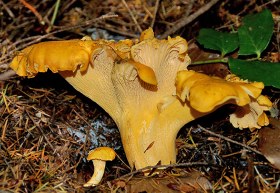 Golden Chanterelle (Chanterellus formosus)
|
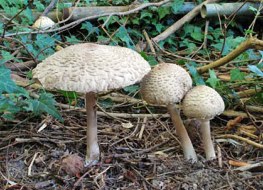 Shaggy Parasol (Chlorophyllum olivieri)
|
 The Prince (Agaricus augustus)
|
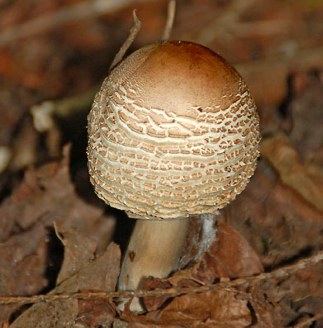 Brown Shaggy Parasol - Chlorophyllum brunneum
|
Dining on Wild Mushrooms
When eating wild mushrooms for the first time, it is advisable to only sample a small amount, a few bites for example to see how our system reacts, instead of enjoying a big dish of "pasta con funghi incogniti". There is not a single mushroom out there that will not cause a negative reaction for someone, including chanterelles and button mushrooms. Furthermore, one should stick with sampling one new species at a time, so if there are complications, one can attribute it to a specific mushroom instead of having to give up on all new mushrooms in the mix. An unattractive alternative is having to try all these mushrooms individually again to find the culprit. And be aware, many adverse reactions to mushrooms come from eating old mushrooms, which would have been unproblematic when consumed fresh. In most such cases the fear resulting from a negative reaction is much worse than your body's physical reaction. Facing an unexpected reaction after having eaten a mushroom one was not so sure about in identification is really downright scary. The fear factor from a possible misidentification cannot be overstated, even if the actual symptoms are rather harmless. In many cases the mental torment is much more acute than the physical problems. And then there are the rare cases in which toxic mushrooms really mess up people's health and the right first step is calling the Poison Control Center at 1-800-222-1222.
|
|
The best way avoiding this 800 number is to learn mushroom hunting from experienced collectors. Some people are lucky enough to have learned their skills from family members who passed on their knowledge. Learning from friends is a great experience too, but often experienced mushroom collectors are very reluctant to take local friends to their hunting grounds, since there is a great likelihood that next year your friend might beat you to your spot. For many of us the easiest way to learn the ins and outs of foraging for wild edible mushrooms is joining a mushroom club or mycological society. I have many West Coast clubs listed on my Fungal Links. Most of these clubs offer mushroom identification, forays, monthly meetings, wild mushroom exhibits, cooking events and other fungal fun. Bigger mycological societies also offer classes to introduce people to the collection of wild edible mushrooms, PSMS for example offers such classes in spring and fall and I frequently volunteer as a presenter. Also joining a mushroom club is a great way to connect with like-minded people and there is much to learn about the environment, cooking, crafts etc. beyond mushrooms. I have benefited incredibly by being an active member in the Puget Sound Mycological Society.
|
|
|
Mushroom Identification Services
Most Mycological Societies offer mushroom identification as a free service. You can always bring specimens to club meetings, where they will be ID'ed for you. Sharing mushroom photos on the internet or by email is a very convenient way to solicit someone else's opinion, but unfortunately is often not sufficient for reliable identification. Also, you could take your mushrooms to a local identifier. The Puget Sound Mycological Society (check under contacts at www.psms.org) could provide you with a phone number of an ID person to consult, be it near your home or work place. If you should live in Kirkland, Kenmore, Bothell or Woodinville, PSMS would probably provide you with my phone number.
Well, that is how it used to be. Now we do have on Mondays during the mushroom spring and fall season ID assistance at the Center for Urban Horticulture. Check the PSMS webpage for the actual time and if they are offered.
|
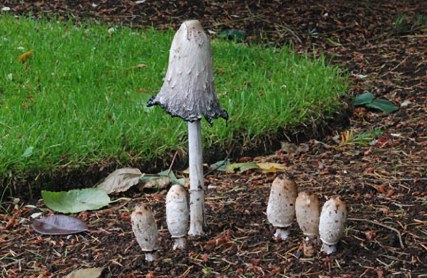 Shaggy Mane (Coprinus comatus)
|
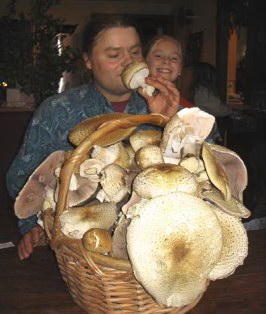 Princes galore! A basket full of Agaricus augustus, Kirkland WA, September 2004 © Daniel Winkler
|
Under certain circumstances all these approaches and resources listed above might neither meet your specific needs nor your schedule.
You might like to have a private mushroom prefer to - Set your own time
- Receive a personal introduction to mushroom hunting
- Give a mushroom hunt as a birthday gift
- Find a specific culinary mushroom
- Be out in the woods with a mushroom expert
- Select your favorite habitat or search your own property
Talking about habitat, you might have mushrooms on your property, be it forested acreage or a regular backyard; Or you keep seeing all these mushrooms where you usually go for a walk and you would love to have someone with you that can identify these mushrooms and inform you if they are edible, worthless or poisonous.
If you are interested in soliciting my mushroom guiding services, please send me an email so we can discuss details.
|
Daniel grew up in Munich, Bavaria, and started hunting Steinpilz (Boletus edulis) with his family at age 3. In his early years Daniel was glad to supply his parents with the chanterelles, hedgehogs and boletes that they treasured so much. Finding mushrooms was just as exciting as finding Easter eggs, an excitement that is still to be had each time hunting for mushrooms. Eating wild mushrooms became a joy after discovering the rich aroma of parasols. Later Daniel studied geography, ecology and botany (including some disappointingly boring mycology lectures) in order to work on environmental issues in the Himalayas and Tibet, where he has been researching and consulting since the 1990s. As part of his research Daniel has been focusing on medicinal and edible mushrooms in Tibet for many years and has published many scientific papers (professional resume). His Yartsa gunbu (Caterpillar fungus - Ophiocordyceps sinensis) research has been featured in The Economist, National Geographic, New York Times, Washington Post, NPR, BBC World Service etc. In the last decade Daniel started exploring neotropical fungi, consulting Netflix for "Our Planet" Jungles episode on Cordyceps fungi and working on an edible neotropical fungi project for Amazon Conservation Team in Suriname since 2018. With his travel agency MushRoaming Daniel is organizing mushroom focused eco-adventures to Bhutan, Tibet, the Amazon, Colombia, the Austrian Alps and the Pacific Northwest since 2007. Besides this Daniel has been writing articles on mushrooms for a range of popular magazines and provided his photos for many publications.
In 1996, Daniel moved to Seattle and upon his first visit to PSMS' annual wild mushroom exhibit joined the Puget Sound Mycological Society. Being part of PSMS enticed him to take his life-long love for mushrooms to a whole new level. Daniel trained to become a mushroom identifier for the club and teaches classes. Daniel was Vice President and Speaker chair from 2016 to 2020. He keeps venturing out into new and old habitats and cultures to feed his curiosity and his family, along the way capturing images and gathering stories to share in his writings and presentations. ![]()
Hi Daniel,
Thanks so much for our wonderful adventure. It exceeded all expectations, and the “kids” kept talking about how it was the highlight of their visit to the Pacific Northwest. You’ve motivated a number of us, myself included, to further studying mycology. Many thanks for the detailed photos and descriptions of the mushrooms we found. Our oyster pasta was excellent! Emma and Bobby made fettuccini with the oyster mushrooms in a light cream sauce. There were plenty of mushrooms to go around for 8 people. I hope you will be open to guiding us again some day. We really appreciate your in-depth knowledge and enthusiasm as a teacher, your willingness to answer all our many questions and show us how to get down into the muck in the forest.
Maggie Lohnes, June 2021
Mushroom magic!
I can’t say enough times what an ideal experience this was for our family - from our 13 year old right to 70, we were all so thoroughly entertained and engaged. Daniel shared with us an enormous amount of information about the forest around us and underfoot and kept us all regaled with countless tales and knowledge about his own far flung “Mushroaming” excursions all around the globe. Daniel is a fountain of fascinating and very fun knowledge that each one of us was more than happy to absorb along the way. It is always so incredible to find people who can share such heavy duty scientific info in an accessible and highly digestible way! The 4 hrs simply flew by and left us eager for another “Mushroam“ in the spring when we return to the PNW.
Our afternoon was beyond fruitful (we hauled in 2 heaping shopping bags of late season chanterelles on a beautiful December day!); we learned so much, drank in the delicious fresh, ferny air and spent a truly quality afternoon together in the woods. We can not wait to get back out there with our snazzy new Mushroaming knives and our newly found fungal identification knowledge!
Erin Baylis, Dec. 2020
"Daniel took our family for a mushroom roam and we had the most amazing time! Daniel is a great teacher and storyteller. Our group included a mix of adults and small kids and he was able to keep everyone engaged. We learned a lot about a wide variety of mushrooms, not just the popular or common ones. Daniel even provided recommendations on how to cook and enjoy the different mushrooms that we found - we especially loved his Russula hummus recipe. We are new to the Pacific Northwest region and new to mushrooms but now we feel much more confident going mushroom hunting on our own! I can't thank you enough for the experience.
Best, Aviva, Seattle WA Nov. 2020
Hey Daniel, the mushroom season was fantastic, thanks to you! I’m so glad we went out with you. It was really a lot of fun, and we learned so much! Our eyes are open to mushrooms everywhere. We also ordered some oyster grow at home kits which have been very entertaining. We enjoyed your talk at the mycological society, and on my Facebook feed I see a constant stream of mushrooms from a couple of different groups. That has helped familiarize me with some common types. Of course, we are still rank beginners, but we are learning. We would enjoy going out with you again sometime. Thank you for being such a fun, interesting mushroom guide. You’ve helped open our eyes to a whole new aspect of nature which we’d heretofore overlooked.
Dan K., Seattle 10-2020
Yes a few years missing here when I did not upload testimonials...
Elly & Doane, Seattle WA, Oct. 2009
